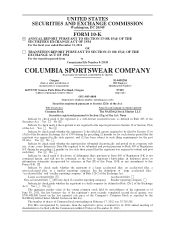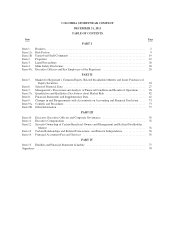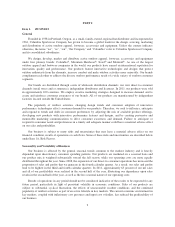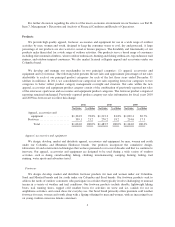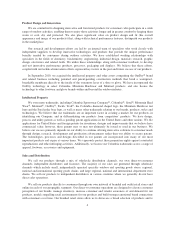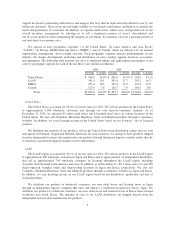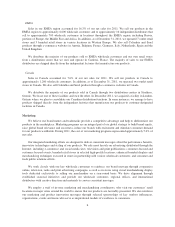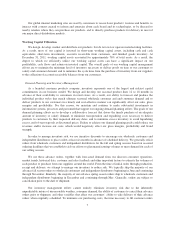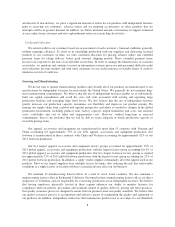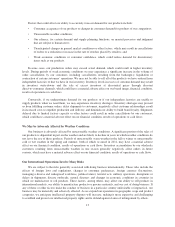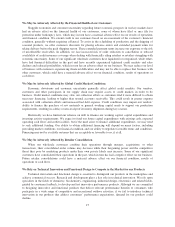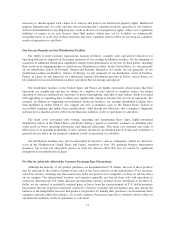Columbia Sportswear 2011 Annual Report Download - page 15
Download and view the complete annual report
Please find page 15 of the 2011 Columbia Sportswear annual report below. You can navigate through the pages in the report by either clicking on the pages listed below, or by using the keyword search tool below to find specific information within the annual report.Our Success Depends on Our Business Strategies
Our business strategies are to achieve sustainable, profitable growth by creating innovative products,
elevating consumer perception of our brands, improving our operating flexibility and efficiency, increasing
consumer and retailer awareness and demand for our products, creating compelling retail environments, and
building stronger emotional brand connections with consumers over time. We intend to pursue these strategies
across our portfolio of brands, product categories and geographic markets. We face many challenges in
implementing our business strategies. For example, our focus on innovation depends on our ongoing ability to
identify, develop or secure rights to product improvements or developments through internal research, joint
developments, acquisitions or licenses. However, these innovations and developments may not be profitable or
have the desired effect of increasing demand for our products. The failure to implement our business strategies
successfully could have a material adverse effect on our financial condition, results of operations or cash flows.
To implement our business strategies, we must continue to modify and fund various aspects of our business,
to maintain and enhance our information systems and supply chain operations to respond to changes in demand,
and to attract, retain and manage qualified personnel. Changes in our business, including efforts to contain costs,
may place an increasing strain on management, financial, product design, marketing, distribution, supply chain
and other resources, and we may have operating difficulties as a result. For example, in support of our strategic
initiatives, we are making significant investments in our business processes and information technology
infrastructure that require significant management attention and corporate resources. In addition, we may need to
adapt our information technology systems and business processes to integrate business acquisitions. These
business initiatives involve many risks and uncertainties that, if not managed effectively, may have a material
adverse effect on our financial condition, results of operations or cash flows.
Our business strategies and related increased expenditures could also cause our operating margin to decline
if we are unable to offset our increased spending with increased sales or gross margins, or comparable reductions
in other operating costs. If our sales or gross margins decline or fail to grow as planned and we fail to sufficiently
leverage our operating expenses, our profitability will decline. This could result in a decision to delay, reduce,
modify or terminate our strategic business initiatives, which could have a material adverse effect on our financial
condition, results of operations or cash flows.
We Depend on Independent Factories
Our products are produced by independent factories worldwide. We do not own or operate any production
facilities. Although we enter into purchase order commitments with these independent factories each season, we
generally do not maintain long-term manufacturing commitments with them. Without long-term or reserve
commitments, in a capacity-constrained environment, there is no assurance that we will be able to secure
adequate or timely production capacity or favorable pricing if growth or product demand differs from our
forecasts. Independent factories may fail to perform as expected or our competitors may obtain production
capacities that effectively limit or eliminate the availability of these resources to us. If an independent
manufacturer fails to ship orders in a timely manner or to meet our standards or if we are unable to obtain
necessary capacities, we may miss delivery deadlines or incur additional costs, which may result in cancellation
of orders, refusal to accept deliveries, a reduction in purchase prices or increased costs, any of which could have
a material adverse effect on our financial condition, results of operations or cash flows.
Reliance on independent factories also creates quality control risks. Independent factories may need to use
sub-contracted manufacturers to fulfill demand and these manufacturers may have less experience producing our
products or lower overall capabilities, which could result in compromised quality of our products. A failure in
our quality control program may result in diminished product quality, which in turn could result in increased
order cancellations and returns, decreased consumer demand for our products, or product recalls (or other
regulatory actions), any of which could have a material adverse effect on our financial condition, results of
operations or cash flows.
10


